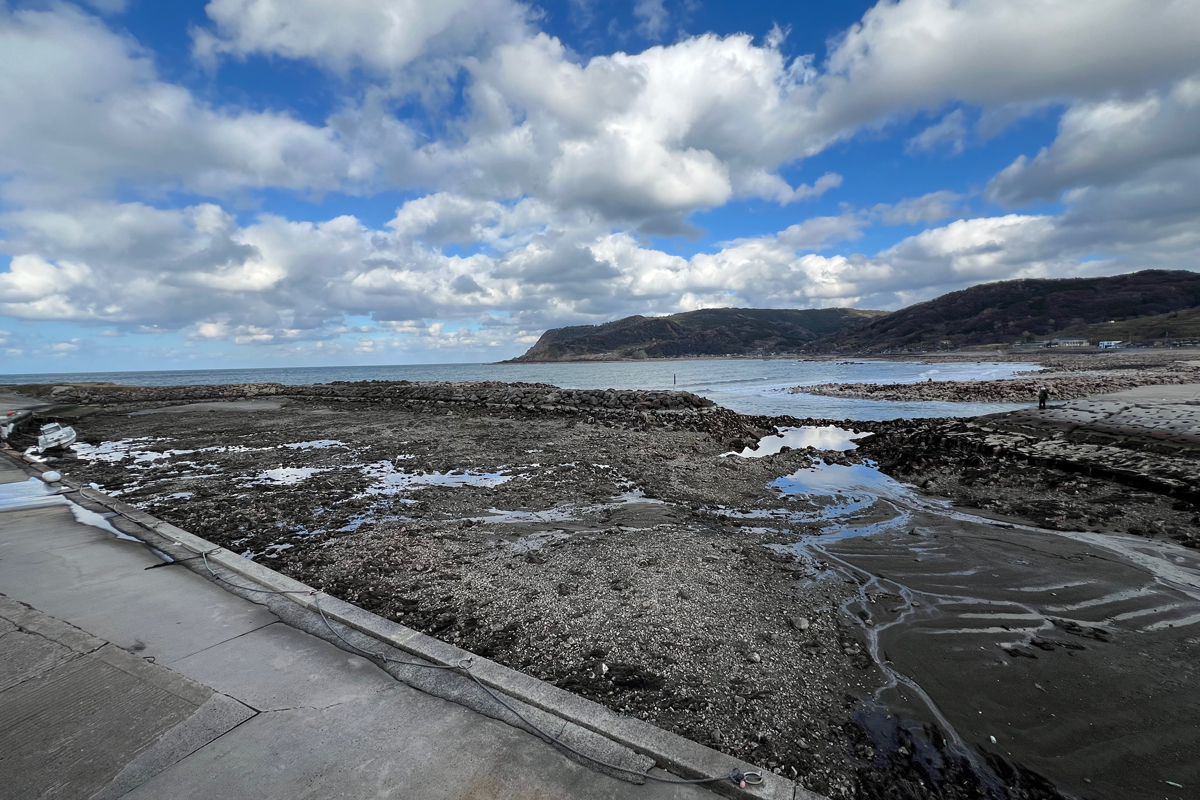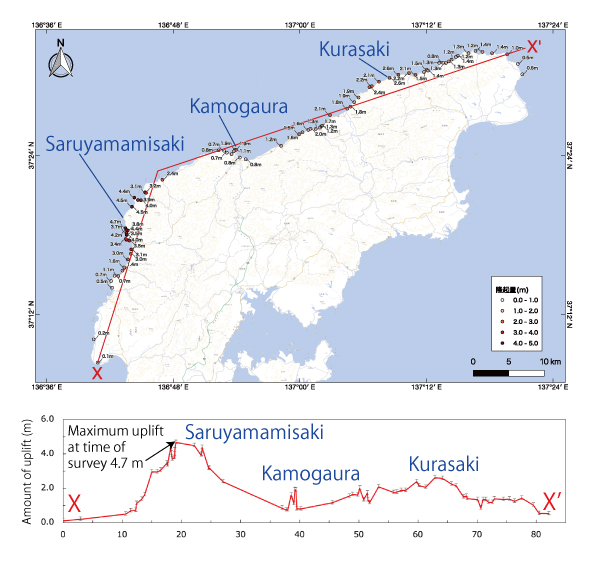Geological data shed light on past, future quakes in Sea of Japan

The Noto Peninsula Earthquake, which struck Japan’s north central region on Jan. 1, 2024, registered the maximum seismic intensity of 7 on the Japanese scale and caused the uplift of the coast and ocean floor. Associate Professor Tatsuya Ishiyama of the Earthquake Research Institute’s Research Center for Monitoring Japan Arc explains why a massive earthquake occurred on the Noto Peninsula and what data about geomorphic, geological and crustal structures can tell us about past and future earthquakes in the Sea of Japan region.

Photo of coastal uplift measuring 4.1 meters taken at Igisu fishing port in the city of Wajima, Ishikawa Prefecture, on Jan. 4, 2024.
(Source: Ishiyama, Hirouchi, Matta, Tateishi, and Yasue, 2024*1).
Noto Peninsula in the context of Japan’s geological history
―― What can you tell us about the geomorphology, which describes the landforms — the distinctive, natural features on the land surface — of the Noto Peninsula?
If we compare the coastal landforms before and after the Noto Peninsula Earthquake, we can see that the resulting coastal uplift dried up beaches and fishing ports. We also know that the coastline advanced by several hundred meters in a number of locations. Post-earthquake surveys confirmed that there were about 4-5 meters of uplift at the most extreme points.

The Sea of Japan region, on the western coast of Japan, where Okushiri Island, Sado Island and the Oga and Noto peninsulas are located, is known for its intense crustal and seismic activity. This is especially true for the Noto Peninsula, as it is surrounded by many nearshore active faults. On the peninsula, you can find landforms known as marine terraces that are more than 100 meters above sea level; they depict coastal features from over 120,000 years ago, which means that the land has been uplifted by an average of 1 millimeter per year for over 100,000 years – this is quite fast compared to other regions.
Although we still do not fully understand the reason for such intense crustal activity in the Sea of Japan, we have to think about it in terms of the origin of the Japanese islands themselves. Approximately 15 million to 20 million years ago, a part of the Eurasian continent was pulled apart several hundred kilometers from the mainland, thus opening the Sea of Japan and forming the Japanese islands. There are various theories about the mechanisms behind the opening of the sea, but the large extensional forces exerted during the process nevertheless resulted in the concentration of many faults along the coast. Like old wounds from the sea opening, these faults are thought to be active today because they are currently subject to east-west compressive forces due to, for example, the subduction of the Pacific Plate beneath Japan’s main island Honshu.
―― Is there any evidence of a large earthquake occurring on the Noto Peninsula before?
Careful observation of the coastal landforms reveals evidence of intermittent uplift over a period of approximately several thousand years, which suggests repeated large earthquakes in the past. We also know that earthquakes have happened in the past because trace fossils of coastal marine worms can be found at higher elevations than is typical. However, we have not yet found any clear evidence on land of a previous earthquake comparable to the seismic event on Jan. 1.
Most of the previous inland earthquakes in Japan that exceeded magnitude 7 were caused either by the rupture of a single fault or by the successive rupture of several faults extending for several dozen kilometers. In contrast, past large earthquakes in the Sea of Japan — such as the Shakotan Peninsula (1940), Niigata (1964), Nihonkai-Chubu (1983) and Hokkaido Nansei-Oki (1993) earthquakes — have commonly measured in the upper half of magnitude 7, with rupture lengths longer than 100 km. The epicenters of most of these were also offshore. In other words, the main cause of damage from these earthquakes was the resulting tsunami.
The fault rupture from the Noto Peninsula Earthquake was around 150 km long, but it was located at the boundary of land and sea, resulting in both a tsunami and strong ground shaking occurring simultaneously that caused major damage to populated areas on land.
Understanding earthquakes at the land-sea boundary
―― What are some of the characteristics of earthquakes that happen at the land-sea boundary?

Active inland faults leave behind some evidence of past large earthquakes, and by using methods like on-site trench and borehole drilling surveys, we can determine when they occurred and how big they were. We can also find information about past earthquakes written in historical records. However, we have very little information about past earthquakes in the Sea of Japan compared to the gigantic earthquakes along the Nankai Trough, the Japan Trench and inland active faults. The geomorphic and geological records of active faults are often incomplete and there are many things we still do not know. Combined with the fact that the cost of conducting surveys offshore is much higher than on land, acquiring the data that we are missing is no simple task.
It is even more difficult to conduct surveys at the boundary between land and sea, which is commonly used for commercial fishing. In shallow waters, even if we do manage to install seismometers, the noise generated by tidal currents creates disruptions in the recording. Moreover, signs of past earthquakes with severe uplift might be erased by wave erosion, resulting in less and less information about seismic activity and crustal deformation in that area.
―― What were you looking for in your surveys immediately following the earthquake?

I had been visiting the Noto Peninsula from before the earthquake for a project involving subsurface structure exploration and variable geomorphic surveys with researchers from the University of Toyama, Okayama University, Shinshu University and others. In the aftermath of the Jan. 1 earthquake, some areas became inaccessible due to snow and landslides, but members of the University of Toyama arranged transportation, and we arrived at the site on Jan. 3. It was necessary for us to access the area immediately after the disaster to investigate and record how the coastal geomorphology had changed when the earthquake struck, before erosion and recovery work covered up or altered the evidence.
The Japanese government uses long-term earthquake forecasting in order to assess the likelihood of an earthquake occurring in the next 30 years. It does this by drawing on geomorphic, geological and historical data to estimate the timing and magnitude of past major earthquakes stretching back several thousand years. However, the information we can obtain from these data is often incomplete, much like a puzzle with missing pieces. It is extremely important to try to fill in these gaps when an actual earthquake occurs by comprehending how the coast has changed so far and how it will continue to change hundreds of years from now. Understanding the various scales and patterns of seismic activity, such as that of the Noto Peninsula Earthquake, allows us to more realistically estimate potential earthquakes. The earthquake on Jan. 1 will serve as an important case study for understanding other earthquakes and active faults that lie on the land-sea boundary.
We express our deepest sympathies to the victims of the earthquake and all those involved, and we wish for the swiftest possible recovery. We hope that by collecting as much data as possible on earthquakes when they happen, we will be able to better understand seismic phenomena and prepare for future earthquake disasters.
*1Ishiyama, Tatsuya, Daisuke Hirouchi, Nobuhisa Matta, Ryo Tateishi, and Ken’ichi Yasue. (2024). “Coseismic coastal uplift associated with 2024 Noto Peninsula Earthquake (Preliminary Report 2).” Earthquake Research Institute, The University of Tokyo.
*2Yasue, Ken’ichi, Ryo Tateishi, Tatsuya Ishiyama, Nobuhisa Matta, Daisuke Hirouchi, and Yoshiki Shirahama. (2024). “Coseismic coastal change associated with the 2024 Noto Peninsula Earthquake.” Program and Proceedings of the Emergency Symposium on the 2024 Noto Peninsula Earthquake, p. 11. The Association of Japanese Geographers Noto Earthquake Disaster Response Headquarters.
*3Ishiyama, Tatsuya, Ryo Tateishi, and Ken’ichi Yasue. (2024). “Coseismic coastal uplift associated with 2024 Noto Peninsula Earthquake (Preliminary Report 4).” Earthquake Research Institute, The University of Tokyo.

Tatsuya Ishiyama
Associate Professor, Research Center for Monitoring Japan Arc, Earthquake Research Institute
Ph.D. from the Division of Earth and Planetary Sciences in the Graduate School of Science at Kyoto University. Before assuming current post in 2024, held positions as a researcher in the Active Fault Research Center at the National Institute of Advanced Industrial Science and Technology; assistant professor in the Department of Earth Science at Tohoku University; and assistant and associate professor in the Earthquake Prediction Research Center in the Earthquake Research Institute at the University of Tokyo. Contributing author of the edited volume Atlas of Quaternary thrust faults in Japan (University of Tokyo Press, 2002), and co-author of numerous journal articles, including “Structures and active tectonics of compressionally reactivated back-arc failed rift across the Toyama trough in the Sea of Japan, revealed by multiscale seismic profiling” (Tectonophysics, July 25, 2017).
Interview date: April 4, 2024
Interview: Yuki Terada, Hannah Dahlberg-Dodd






